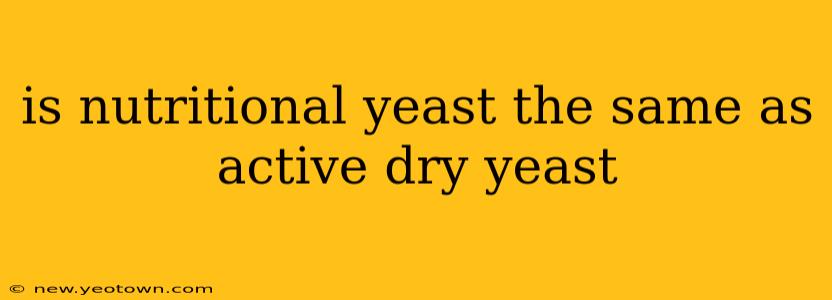Is Nutritional Yeast the Same as Active Dry Yeast? A Deliciously Informative Deep Dive
Let's settle this once and for all: no, nutritional yeast and active dry yeast are not the same. While they share a common ancestor—Saccharomyces cerevisiae—their uses, flavors, and nutritional profiles are vastly different. Think of them as distant cousins who've taken very different paths in life. One's a culinary workhorse, the other a nutritional powerhouse.
Imagine two siblings: one, a tireless baker always ready to rise to the occasion (active dry yeast), and the other, a health-conscious foodie with a cheesy, nutty charm (nutritional yeast). Let's explore their distinct identities.
What is Active Dry Yeast?
Active dry yeast is a living organism. It's the key ingredient that makes bread, pizza dough, and other baked goods rise. When activated with warm water and a touch of sugar, these tiny organisms feast, producing carbon dioxide gas. This gas creates the air pockets that give baked goods their fluffy texture. It's a vital component in fermentation processes, contributing to the rise and flavor development of various foods.
In short: Active dry yeast is a leavening agent for baking and fermentation. Trying to use it as a nutritional supplement would be like trying to use baking soda as toothpaste—it's not designed for that purpose.
What is Nutritional Yeast?
Nutritional yeast, on the other hand, is a deactivated yeast. It's grown, harvested, and then heated to a high temperature, killing the yeast cells. This process deactivates its leavening power. Instead, it becomes a source of various nutrients, including protein, B vitamins (especially B12, crucial for vegans), fiber, and minerals. It has a savory, nutty, and sometimes cheesy flavor, making it a popular addition to many dishes. You'll often find it sprinkled on popcorn, pasta, or used in vegan cheese sauces.
In short: Nutritional yeast is a deactivated yeast used as a nutritional supplement and a flavor enhancer. It cannot be used to leaven bread.
What are the key differences between nutritional yeast and active dry yeast?
Here's a table summarizing the core differences:
| Feature | Active Dry Yeast | Nutritional Yeast |
|---|---|---|
| State | Living organism | Deactivated, inactive |
| Primary Use | Baking, fermentation | Nutritional supplement, flavor enhancer |
| Flavor | Essentially flavorless | Savory, nutty, cheesy |
| Nutritional Value | Low in nutrients | High in protein, B vitamins, fiber |
| Activation | Requires activation with warm water | No activation required |
Can I substitute one for the other?
Absolutely not! You cannot use nutritional yeast in place of active dry yeast for baking. The deactivated yeast cells in nutritional yeast are unable to produce the carbon dioxide gas needed for leavening. Similarly, you can't use active dry yeast to boost your B12 levels; its nutritional value is minimal compared to nutritional yeast.
Is nutritional yeast good for you?
Nutritional yeast is a complete protein and a rich source of B vitamins. However, as with any supplement, moderation is key.
Is there a way to tell them apart?
Yes! Active dry yeast comes in granular form, while nutritional yeast is typically a fine, yellow powder. The packaging will also clearly indicate whether it's active dry yeast or nutritional yeast.
Hopefully, this clarifies the differences between these two distinctly different, yet equally important, yeast varieties. They both have their place in the culinary world, but their roles are completely separate.

